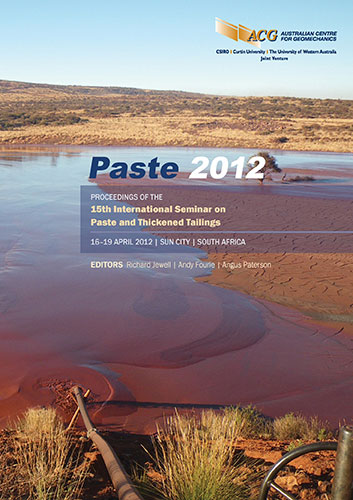Thickening of tailings using hydrocyclones operating under vacuum conditions

|
Authors: van Ryssen, GJ; Steenkamp, PL |
DOI https://doi.org/10.36487/ACG_rep/1263_19_van_Ryssen
Cite As:
van Ryssen, GJ & Steenkamp, PL 2012, 'Thickening of tailings using hydrocyclones operating under vacuum conditions', in R Jewell, AB Fourie & A Paterson (eds), Paste 2012: Proceedings of the 15th International Seminar on Paste and Thickened Tailings, Australian Centre for Geomechanics, Perth, pp. 225-231, https://doi.org/10.36487/ACG_rep/1263_19_van_Ryssen
Abstract:
Many tailings storage facilities (TSFs) on the African continent are constructed by utilising the proven cyclone deposition method. The plant tailings is separated to deliver a coarse sandy underflow to the wall zone of the TSF and the overflow is discharged into the basin. The average percentage of dry gold tailings solids that is available for the wall zone is generally between 20 and 35%. The product is stable and high rates of rise (RoR) can be achieved. The TSF impoundment wall is normally constructed to one vertical and three horizontal (approximately 18°). A vacuum cyclone system has been developed for a mineral sands operation located close to the sea shore on the South African west coast, to flatten the side slopes to one vertical and five horizontal. The reason for the flat slopes is for rehabilitation of the TSF in this very arid part of the country, which is distressed by high velocity northwesterly and southeasterly winds. The tailings density of the TSF averages 1.17 t/m³ and the conventional approach to cycloning is not feasible. With the vacuum system an average underflow of 1.9t/m³ is achieved with the overflow density averaging 1.01 t/m³. The solids recovery achieved for wall flattening is approximately 88.5%. A gold mine in West Africa is utilising this technology in placing approximately 40–50% of the solids pumped to their TSF on the outer wall in the downstream fashion, delaying the need for a new greenfields facility. The existing TSF will have adequate capacity to accommodate the slimes from the plant for Life of Mine (LoM), thus minimising the risk of overloading the facility. This paper describes the process of utilising hydrocyclones operated under vacuum conditions to:
© Copyright 2024, Australian Centre for Geomechanics (ACG), The University of Western Australia. All rights reserved.
View copyright/legal information
Please direct any queries or error reports to repository-acg@uwa.edu.au
View copyright/legal information
Please direct any queries or error reports to repository-acg@uwa.edu.au